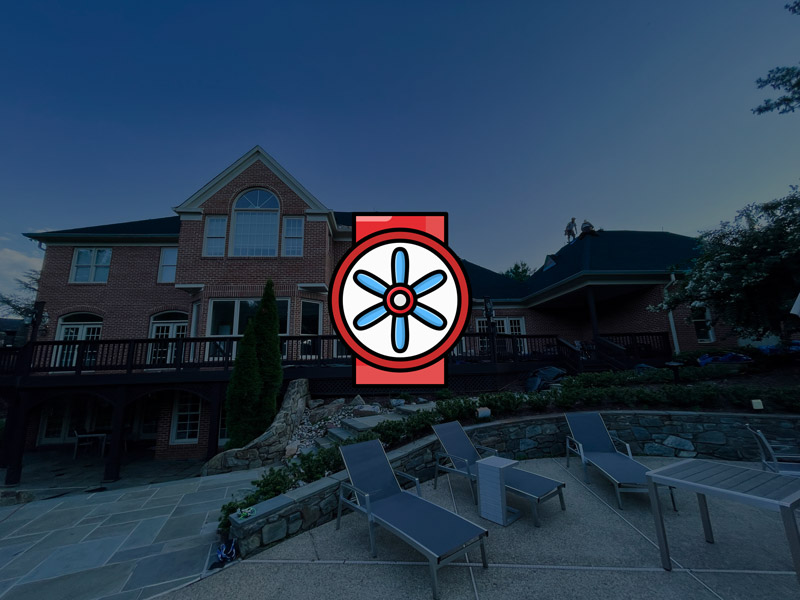Attic Temperature Control: Mastering Energy Efficiency
Effective attic temperature control extends beyond mere comfort; it directly impacts energy consumption and costs. By regulating the temperature in this often-overlooked space, homeowners can curtail excessive energy usage. Without proper management, attics can transform into heat traps, resulting in soaring cooling costs and unnecessary energy waste.

Understanding Attic Temperature Dynamics
Attic temperature control is a complex interplay of several key factors that directly affect the indoor environment’s comfort and energy efficiency.
Insulation Quality Matters
The quality and adequacy of insulation significantly contribute to attic temperature control. Insulation acts as a barrier, inhibiting heat transfer between the attic and the living spaces below. When insulation is lacking or poorly installed, heat from the attic can seep into the home during hot periods, increasing cooling demands. Similarly, during colder months, insufficient insulation allows heat to escape, leading to higher heating requirements.
Ventilation’s Crucial Role
Effective attic temperature control hinges on proper ventilation. Ventilation systems regulate airflow, preventing excessive heat buildup. Without proper airflow, the attic can transform into an oven, radiating heat downwards and making the living areas uncomfortable. Strategic placement of vents, such as ridge vents and soffit vents, ensures a balanced exchange of air, minimizing temperature differentials.
Roofing Materials and Solar Radiation
The choice of roofing materials and their interaction with solar radiation play a pivotal role in attic temperature control. Darker roofing materials tend to absorb more heat, leading to higher attic temperatures. Alternatively, reflective and light-colored roofing materials minimize heat absorption, thereby reducing attic temperature fluctuations. The amount of solar radiation a roof receives directly influences the attic’s heat gain, emphasizing the need for materials that mitigate this impact.
Indoor Climate and Energy Consumption
Temperature variations within the attic cascade down to influence the entire indoor climate. Elevated attic temperatures can lead to increased cooling requirements, causing air conditioning systems to work harder and consume more energy. By contrast, a well-regulated attic temperature translates to more stable indoor conditions, reducing the strain on HVAC systems and contributing to energy savings.

The Role of Attic Insulation
Insulation emerges as a key player in effective attic temperature control due to its ability to create a thermal barrier that minimizes heat exchange.
Ensuring Consistency through Insulation
High-quality attic insulation is a linchpin in achieving and maintaining optimal temperatures. Properly installed insulation acts as a buffer, preventing heat from seeping into living spaces during hot spells and thwarting heat loss in colder periods. This consistency ensures a comfortable indoor environment while curbing energy consumption.
A Range of Insulation Materials
Various insulation materials contribute to attic temperature control, each with its unique attributes. Fiberglass, cellulose, and spray foam insulation are among the popular options. Fiberglass offers excellent thermal resistance, while cellulose excels in noise reduction. Spray foam insulation forms an airtight seal, minimizing heat transfer. Choosing the right material hinges on factors like budget, R-value, and the attic’s structural layout.
Effectiveness in Heat Transfer Reduction
The primary function of insulation in attic temperature control is to curtail heat transfer. Insulation impedes the movement of heat between the attic and living spaces, maintaining a stable indoor climate. It prevents the upward migration of heat during hot weather and inhibits heat loss during colder months. This reduction in heat transfer significantly contributes to energy efficiency.
Tailoring to Location and Climate
Attic temperature control is not a one-size-fits-all approach. Insulation recommendations vary based on geographic location and climate. In colder regions, higher insulation levels are advised to counteract harsh winters, while moderate insulation suffices in milder climates. Understanding the insulation needs specific to your area ensures an optimized approach to temperature management.

Optimal Attic Ventilation Strategies
Achieving effective attic temperature control relies heavily on implementing proper ventilation strategies that thwart heat buildup and maintain a conducive environment.
Preventing Heat Buildup and Moisture Accumulation
Proper attic ventilation stands as a sentinel against heat accumulation. In warmer months, attics can transform into sweltering spaces, radiating heat downwards and compromising indoor comfort. Adequate ventilation facilitates the escape of hot air, ensuring attics remain cooler. Furthermore, it prevents moisture buildup, which can lead to mold growth and structural damage.
Ventilation Methods for Temperature Regulation
Several ventilation methods contribute to efficient attic temperature control. Ridge vents, installed at the peak of the roof, allow hot air to exit through the highest point. Soffit vents, placed at the eaves, facilitate the inflow of cool air. Combining these vents promotes natural convection, expelling hot air while drawing in cooler air. Additionally, attic fans can enhance ventilation, expediting the exchange of air.
The Crucial Role of Balanced Airflow
Balanced airflow is paramount in achieving attic temperature control. Without equilibrium, hotspots can form, leading to uneven temperature distribution. The interplay between intake (soffit vents) and exhaust (ridge vents or fans) ensures consistent air circulation. This balance prevents temperature differentials, maximizing the efficiency of temperature regulation efforts.

Energy-Efficient Roofing Options
When pursuing comprehensive attic temperature control, the choice of roofing materials plays a pivotal role in achieving energy efficiency and sustaining a comfortable indoor environment.
The Impact of Roofing Materials
Selecting the right roofing material contributes significantly to attic temperature control. Energy-efficient options such as cool roofs, reflective shingles, and metal roofing are engineered to mitigate heat absorption. These materials reflect a substantial portion of solar radiation, preventing attic temperatures from soaring and reducing the demand for cooling systems.
Cool Roofs: Reflecting Solar Heat
Cool roofs, aptly named, boast surfaces that reflect a significant portion of the sun’s rays. Their reflective properties keep the roofing material itself cooler, thereby preventing excessive heat from permeating the attic. This can result in decreased indoor temperatures, reduced energy consumption, and prolonged roof lifespan.
Reflective Shingles: A Shining Solution
Reflective shingles possess surfaces coated with reflective granules, effectively bouncing off solar heat. These shingles are available in a variety of colors and styles, ensuring aesthetic compatibility with diverse architectural designs. By opting for reflective shingles, homeowners can significantly contribute to attic temperature control and overall energy efficiency.
Metal Roofing: Efficient Heat Dispersion
Metal roofing stands out for its ability to disperse heat efficiently. It not only reflects sunlight but also rapidly dissipates absorbed heat. This prevents heat transfer to the attic, keeping the space cooler. Metal roofs also have the added advantage of being durable and environmentally friendly, making them a noteworthy choice for attaining effective temperature control.
Realizing the Benefits
Energy-efficient roofing materials offer a dual advantage: curbing attic heat buildup while reducing energy consumption. By considering these options, homeowners can foster a harmonious indoor climate, mitigate excessive energy expenditure, and contribute to a greener environment.

Steps to Achieving Effective Attic Temperature Control
Step 1: Inspect Insulation
Begin by evaluating your attic’s insulation. Check for any gaps, compressions, or deteriorations in the insulation material. Address any issues promptly to ensure a consistent thermal barrier that prevents heat transfer between the attic and living spaces.
Step 2: Identify Ventilation Needs
Next, assess your attic’s ventilation system. Check the condition of existing vents and determine if additional ones are necessary to facilitate balanced airflow. Ensure that soffit vents, ridge vents, and attic fans are functioning effectively to prevent heat buildup and moisture accumulation.
Step 3: Select Appropriate Roofing Materials
When considering attic temperature control, explore energy-efficient roofing materials. Opt for cool roofs, reflective shingles, or metal roofing that align with your preferences and geographic location. These materials play a pivotal role in reflecting solar radiation and maintaining lower attic temperatures.
Step 4: Consult Professional Contractors
For a comprehensive and efficient attic climate management strategy, consider hiring professional contractors. Experts in roofing, insulation, and ventilation can provide tailored recommendations based on your home’s specifications and local climate conditions. Their expertise ensures optimal results.
Step 5: Plan for Installation
Collaborate with the chosen contractors to create a cohesive plan for implementing the suggested improvements. Schedule insulation upgrades, ventilation adjustments, and roofing material installations to maximize the synergy between these elements.
Step 6: Regular Maintenance
After implementing the changes, prioritize regular maintenance. Schedule periodic inspections to ensure insulation integrity, vent functionality, and roofing material performance. Address any issues promptly to sustain effective attic temperature control over time.
View More Articles
Please Share!











